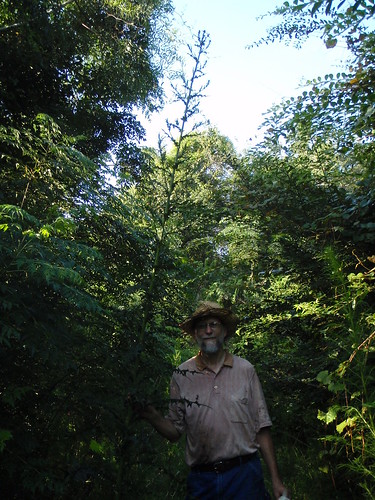Picture by Gretchen.
Yearly Archives: 2009
Black snake in corn field
Justice in Erie County, New York
 Lest anyone think jail problems are just a southern phenomenon, the Buffalo News reports that Erie County, New York’s two jails have a few problems, too:
Lest anyone think jail problems are just a southern phenomenon, the Buffalo News reports that Erie County, New York’s two jails have a few problems, too:
The U.S. Justice Department, after an almost two-year investigation, finds that Erie County’s two jails routinely violate the constitutional rights of their inmates and subjects them to brutality as well poor care on several levels.It turns out the Erie county government went well beyond just not cooperating.In a 50-page report, the Justice Department says the Erie County Holding Center in downtown Buffalo and the Correctional Facility in Alden have failed to correct their numerous problems, even after being warned of them for years by other regulatory agencies.
The Justice Department called the effort by Sheriff Timothy B. Howard’s Jail Management Division to run the two facilities as “woefully inadequate” and said it has led to a “pattern of serious harm to inmates, including death.”
“We conclude that the conditions of confinement violate the constitutional rights of inmates,” the Justice Department said in a letter to County Executive Chris Collins, who had refused to cooperate with the probe.
Maybe if we weren’t locking up more people than any other country in the world, we might not have so many problems with jails.
Cronkite on War on Drugs
 Walter Cronkite died today. I’ll remember him by
what he fought for:
Walter Cronkite died today. I’ll remember him by
what he fought for:
It surely hasn’t made our streets safer. Instead, we have locked up literally millions of people…disproportionately people of color…who have caused little or no harm to others – wasting resources that could be used for counter-terrorism, reducing violent crime, or catching white-collar criminals.With police wielding unprecedented powers to invade privacy, tap phones and conduct searches seemingly at random, our civil liberties are in a very precarious condition.
Hundreds of billions of dollars have been spent on this effort – with no one held accountable for its failure.
Amid the clichés of the drug war, our country has lost sight of the scientific facts. Amid the frantic rhetoric of our leaders, we’ve become blind to reality: The war on drugs, as it is currently fought, is too expensive, and too inhumane.
But nothing will change until someone has the courage to stand up and say what so many politicians privately know: The war on drugs has failed.
LEAP: Law Enforcement Against Prohibition
“We’re all calling for an end to drug prohibition. We want to end it just like we ended alcohol prohibition in 1933,” said Jack Cole, executive director for LEAP. “The day after we ended that nasty law, Al Capone and all of his smuggling buddies were out of business.”

Upset in Lower Lowndes
 In today’s VDT Upset about development:
In today’s VDT Upset about development:
Bill Herndon and his neighbors are unhappy about a development being built in their backyards.Marvin Peavy, now why does that name ring a bell? Ah, yes, CEO and CFO of Lower Lowndes, Inc. the corporation that bought 62.53 acres on Quarterman Road and attempted to rezone it from E-A to R-21 back in 2007. One of the neighbors saw the sign out front and a bunch of us helped convince the County Commission to deny the rezoning.Marvin Peavy, owner of Peavy Properties, has already rented some of the Mar-Mel-Go apartments, and about 70 of the projected 150 apartments have been completed. The other 80 units are scheduled to be added soon.
The two-story apartment buildings rise uncomfortably close to the homes of Pinebrook Drive residents, such as Herndon. Windows of the complex look directly into their backyards and homes.
This time it’s so bad another developer is complaining:
Robert Eddington also lives on Pinebrook Drive. He is a builder and said everyone has a right to develop their property. What he’s disturbed about, among other issues, is that the plans they were shown are not being followed. Eddington was told most of the trees would be spared to protect their privacy, but when he came home several days later, they were all gone except a few.Hm, given that the ULDC got changed a year or so back to require notification of rezoning mailed to adjoining property owners, in addition to a notice in the newspaper and a sign out front, if there was no sign and neighbors didn’t get notices, I wonder if there’s a legal problem with the rezoning.…
Eddington and his neighbors successfully fought a similar development on nearby Water Oak Drive four years ago. They had no such opportunity this time, he said. No notices of any hearing were posted. Neither Herndon nor Fuhrer saw any notices posted announcing zoning or development hearings by the Lowndes County Board of Commissioners.
Ah, this takes me back:
Eddington’s fence was damaged during Mar-Mel-Go construction. When contractors finally fixed it 17 months later, he said his wife asked about the gate that was supposed to be installed. The site manager told his wife that it wouldn’t be installed until the rest of the apartments were completed. Eddington said they were originally told these would be “luxury condos,” but are very different from the way they were described.The previous subdivision (not Peavy’s) that did get built on Quarterman Road (because its zoning was grandfathered in way back in the 1980s) involved a builder shoving building trash through my fence into my field. And streetlights that were installed by the developer but never turned on until the subdivision residents got the Commission to institute a special tax district to pay for them.
Curious how yet again “the plans they were shown are not being followed.”
Maybe if the neighbors go to the county they’ll get redress:
Herndon and his neighbors pooled their money several years ago and spent $4,400 to pave Pinewood Drive, so they feel they have a stake in how the road is used. He approached the Lowndes County Commission about the residents’ concerns and was eventually connected with County Engineer Mike Fletcher.Ah, finger pointing! Not the county government’s problem; it’s up to the property owner. Nevermind the county commission approved the development with certain plans and requirements.Fletcher said a $30,000 siren-controlled gate would be installed on Pinewood Drive for emergency vehicle access only, eliminating unwanted traffic through their neighborhood. The property owner is responsible for installing the gate, said Kevin Beals, Lowndes County development reviewer.
Well, maybe if the neighbors escalate to the county manager:
Lowndes County Manager Joe Pritchard said he thinks Pinebrook Drive residents “have some legitimate questions and we ought to be able to provide a reasonable answer.” Pritchard said he plans to meet with County Engineer Mike Fletcher and Zoning Administrator Carmella Braswell on Monday to discuss the development and see what remedies might be available.Yes, we’ve seen that process many times before. Note he doesn’t say they’ll provide any actual fixes to any of the problems, just “a reasonable answer”. We’ll see if these neighbors get any satisfaction this time.
According to the County Commission calendar, there’s a work session coming up Monday 13 July at 8:30AM and a commission meeting coming up Tuesday 14 July at 5:30PM. The Tuesday public meetings always have an agenda item for Citizens Wishing to the Heard. The work sessions usually don’t, but if you go you can hear what the commissioners have to say about subjects that have come before them, and often you can talk to them directly before or after the meeting.
Commuting Waste Quantified
 Portland, Oregon comes out well on
a recent study of transportation in the U.S.:
Portland, Oregon comes out well on
a recent study of transportation in the U.S.:
Without mass transit, the average Portland area commuter would spend five hours more a year in rush-hour congestion, costing the region $98 million a year in lost time and wasted fuel, the Texas study says.The Texas study is the Urban Mobility Report 2009 from the Texas Transportation Institute. It quantifies what we lose from commuting:
- The overall cost (based on wasted fuel and lost productivity) reached $87.2 billion in 2007 — more than $750 for every U.S. traveler.
- The total amount of wasted fuel topped 2.8 billion gallons — three weeks’ worth of gas for every traveler.
- The amount of wasted time totaled 4.2 billion hours — nearly one full work week (or vacation week) for every traveler.
- Get as much use as possible out of the transportation system we have.
- Add roadway and public transportation capacity in the places where it is needed most.
- Change our patterns, employing ideas like ridesharing and flexible work times to avoid traditional “rush hours.”
- Provide more choices, such as alternate routes, telecommuting and toll lanes for faster and more reliable trips.
- Diversify land development patterns, to make walking, biking and mass transit more practical.
- Adopt realistic expectations, recognizing for instance that large urban areas are going to be congested, but they don’t have to stay that way all day long.
Ten Foot Thistle
Sycamores
Happy Fourth
 In memory of that old privateer, Commodore Essex Hopkins (1718 – 1802),
first ranking officer of the U.S. Navy, and my great-great-great-great-great-grandfather, here’s a picture of the Commodore’s flag: DONT TREAD ON ME.
In memory of that old privateer, Commodore Essex Hopkins (1718 – 1802),
first ranking officer of the U.S. Navy, and my great-great-great-great-great-grandfather, here’s a picture of the Commodore’s flag: DONT TREAD ON ME.



